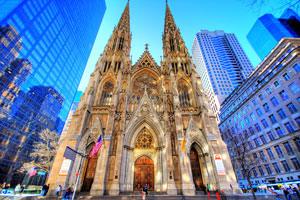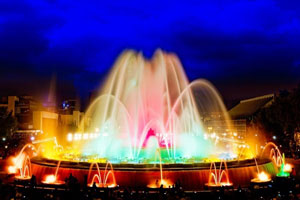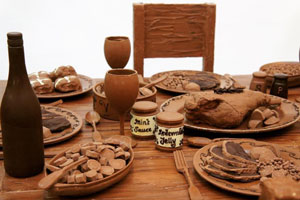ports barcelona sagrada familia inside ahoy 200Barcelona is mostly popular by the work of Antoni Gaudi (1852 – 1925) – the famous architect whose one-of-a-kind revolutional style reflected his passions in life – architecture, nature and religion, implementing the forms of nature, sculpture and light into his designs. Sagrada Familia (the Church of the Holy Family) is the work of his life, still unfinished to this day and his most famous building. The conception of the church is based on the traditions of Gothic and Byzantine places of worship. The sense of religion is communicated through the forms, iconography and the sculpture of the building and Christian symbols can be found everywhere. At Park Guell you can find bright examples of his implementation of “trencadis” – a decoration technique, using waste ceramic pieces, as well as the best views of the city, while sitting on the 100 metres of curved, colourful benches. Learn more about his unique style and life at his House Museum.

Casa Battlo,
called the House of Bones by the locals, is famous for the arched roof, resembling the back of a dragon or a dinosaur. The Palau Guell Mansion is one of the architect’s early buildings, designed as a mansion for the wealthy industrialist Eusebi Guell and apartments to be sold on the upper floors. Casa Mila, known as the “stone quarry” was a private residence, controversial at the time, because of it’s self-supporting stone façade, free-plan floor, underground garage, a spectacular roof-top terrace and unique, soldier-shaped chimneys. Casa Vicens is the building that has most recently been opened to the public, and the first house, designed by Gaudi. It’s considered the first Art-Nouveau building and is very different from the later work of the architect with its straight geometrical lines and bright green and white tiles.

Another emblematic piece of architecture that represents Barcelona is the Gothic Cathedral (with a full name Cathedral of the Holy Cross and Saint Eulalia), built as early as 13th century, although the oldest findings of an early Christian church date back to the 4th century. The cathedral is dedicated to the martyr Santa Eulalia, the patron saint of Barcelona. She was tortured and killed by Romans, when she was only 13 years old. The neo-gothic style façade of the church and the two side towers were inaugurated in 1913 and today this is the seat of the Archbishop of Barcelona.

nother must-see is the Montjuic Hill – there is a lot to see and do there, starting by taking a cable ride to it. The MNAC Museum or the National Art Museum of Catalonia is here, showcasing the largest collection of Catalan art in the world. See Poble Espanyol – this Spanish Village is an open-air permanent exhibit of 117 buildings from all over Spain. La Fundacio Miro is a place, purposely built to showcase Joan Miro’s work. It’s one of a few museums in the world, where the work of an artist shines both in the interior and exterior of the building. El Jardin Botanico is a Mediterranean garden, built to preserve over 1500 plant species worldwide. The Magic Fountain is a fountain built in 1929 for just a year, comprising of waterfalls and ponds that display colour, light, motion and music to create a magical show.

here is so much more art and history to admire in Barcelona, time permitting. Don’t miss the MUHBA Museum to familiarise yourself with the history of the city of Barcelona. The Barcelona Museum of Contemporary Art (MACBA) is showcasing around 5000 works, dating from the mid-20th century onwards. See the CosmoCaixa – considered to be the biggest science museum in Europe is an intriguing space that showcases the environment, nature, science and space. There is also a planetarium and the “Flooded forest” – a stunning recreation of 1000 sq.km. of Amazonian rainforest ecosystem with flora and fauna, typical to the zone. The smaller, but fascinating Museum of Chocolate tells the story of chocolate, but also displays a lovely and tasty, ever changing collection of chocolate sculptures. See the Museum Maritim for the history of navigation, as well as the history of the Spanish Navy since the Catholic Monarchs. If you haven’t seen enough art yet, head over to the Centre de Cultura Contemporania de Barcelona (CCCB) – an arts centre, that showcases the city and urban culture by exhibitions, debates, festivals and concerts. ports barcelona chocolate sculptures ahoy 200The Picasso Museum, although missing some of the artist’s most famous works, displays pretty much all the rest of them – with 4251 paintings, it holds the largest collection of Picasso’s art. This is the first Museum, dedicated to Picasso and the only one, created during his life.

When you are ready to spend some time outdoors, admiring the lovely weather, street art performers and local food, head over to one of the beaches that surround the city. There are also a couple of interesting markets to buy local produce from – the La Boqueria and the Palo Alto Market are the most popular ones. The Camp Nou Stadium is also a local landmark, second most popular after the Sagrada Familia. Breath the fresh air at Parc del Laberint d’Horta and be careful not to get lost at the labyrinth – it’s harder than it looks. Go to Parc de la Ciutadella for a short boat trip around the lake.
